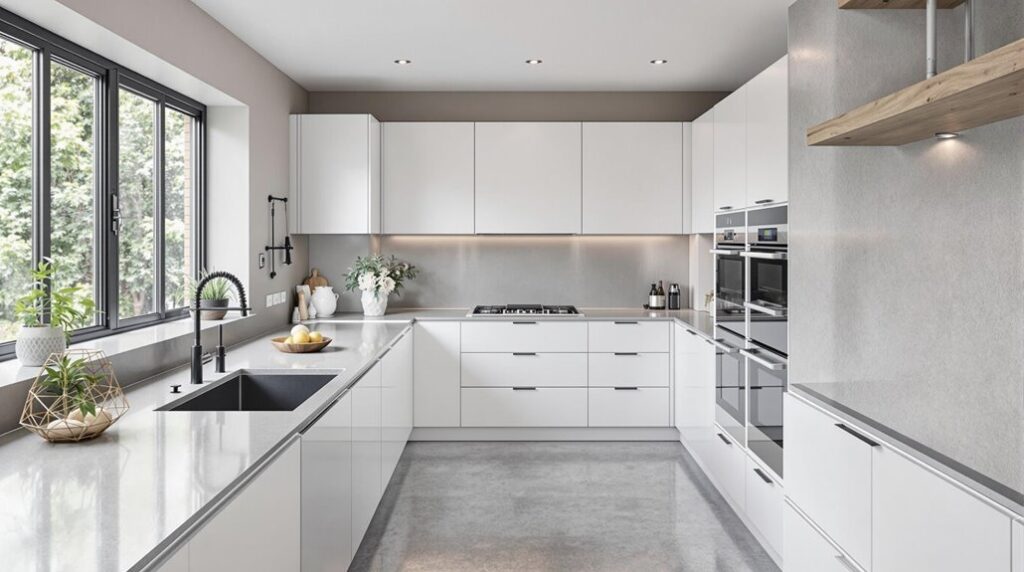I’ve been watching UK homeowners struggle with traditional renovation materials that crack, stain, and require constant upkeep. That’s when I discovered micro cement finishes – a game-changing solution that’s transforming how we approach modern renovations. This seamless material doesn’t just look stunning; it solves the practical problems you’re probably facing right now in your own home. But there’s something vital you need to understand before making this investment.
Key Takeaways
- Micro cement creates seamless, durable surfaces that can be applied over existing tiles, walls, and floors without costly demolition.
- Standard application costs range £100-£180 per m² with minimum project fees of £3200-£4200 plus VAT depending on surface type.
- Installation requires minimum six days with multiple layers and curing periods, making careful project scheduling essential for renovations.
- 2025 design trends favor micro cement’s compatibility with colour drenching, warm minimalism, and textured materials for contemporary interiors.
- Exceptional water resistance, anti-slip properties, and low maintenance make it ideal for UK bathrooms and high-traffic areas.
What Makes Micro Cement the Ultimate Renovation Material
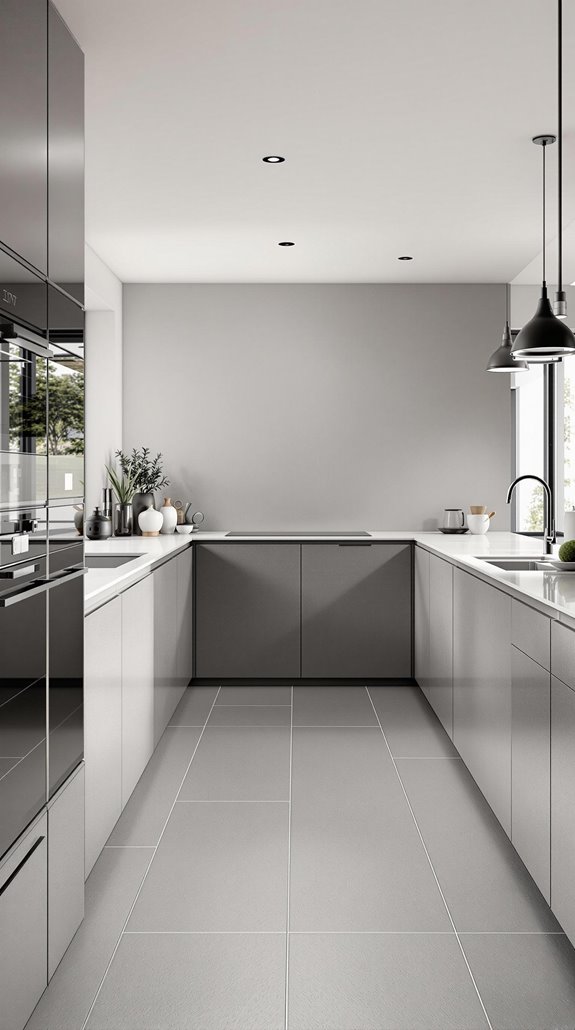
When traditional renovation materials fall short of modern demands, micro cement emerges as the superior choice for UK property transformations. I’ve witnessed how this innovative material delivers exceptional durability that withstands heavy use and extreme conditions while resisting cracking, chipping, and wear in high-traffic areas.
What sets micro cement apart is its remarkable resistance to water, scratches, and stains, making it perfect for wet areas like bathrooms. The seamless application over existing surfaces eliminates costly demolition, while excellent adhesion works across tiles, cement, and plasterboard.
The aesthetic possibilities are endless—from sleek contemporary finishes to bespoke designs in countless colours and textures. The material’s inherent flexibility allows it to absorb impacts and movements effectively, preventing the formation of cracks over time. Combined with low maintenance requirements, food-safe properties when sealed, and sustainable lightweight composition, micro cement represents the future of UK renovations.
Transform Any Surface With Versatile Application Options
The true power of micro cement lies in its ability to transform virtually any surface in your home without the need for costly removal or replacement. I can apply it directly over existing tiles, painted walls, concrete floors, and even wood surfaces with proper preparation. You’ll appreciate how this eliminates demolition waste while cutting renovation time dramatically.
The key lies in substrate-specific preparation. I’ll clean all surfaces thoroughly, repair any cracks, and apply the correct primer for your particular material. Wood requires moisture-resistant primers, while metal needs anti-corrosive treatment. Once prepared, I’ll trowel the base coat thinly, allow 24-hour drying, then apply the second coat perpendicular to the first. This creates seamless, continuous surfaces that make small spaces feel larger.
For optimal results, I ensure the surface maintains proper absorbency levels as this characteristic significantly aids the adhesion process and creates a stronger bond between the microcement and your existing substrate.
2025 Design Trends Perfect for UK Homes
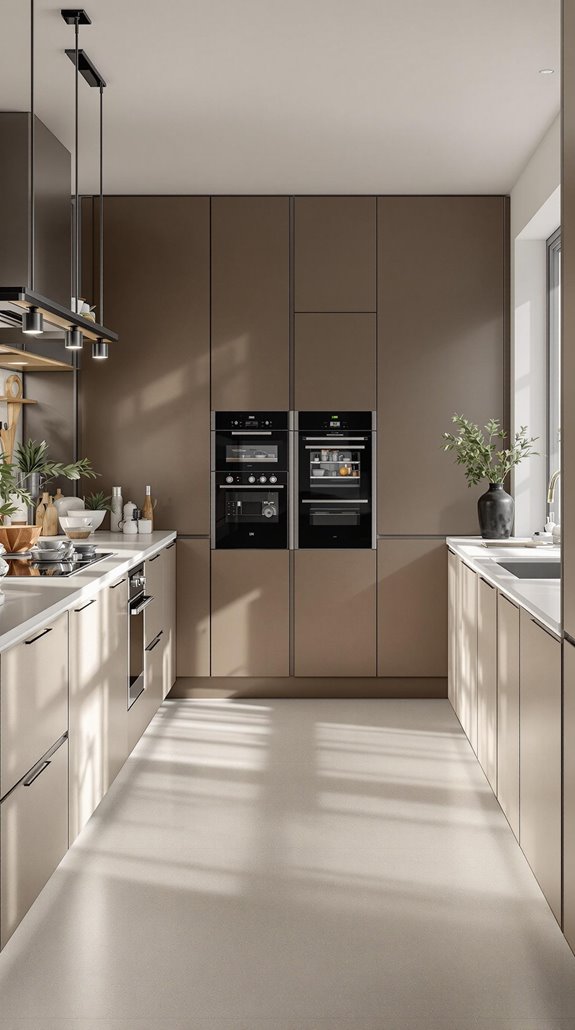
Since micro cement’s neutral base adapts to any aesthetic, I’ll show you five trending design approaches that work exceptionally well in UK homes.
Colour drenching involves using the same colour on walls, ceilings, and trim for a cohesive look that’s becoming very popular for 2025. Micro cement’s seamless application makes this technique particularly effective.
Wood-drenched interiors pair beautifully with micro cement’s organic texture. With oak kitchen searches up 214% and wood kitchen inquiries rising 116%, you can combine micro cement surfaces with extensive wood elements.
Warm minimalism embraces simplicity with creamy beiges and terracotta tones that complement micro cement’s natural finish. This approach works particularly well when incorporating mixed metal finishes to create a layered, curated look throughout the space.
Textured materials add depth through tactile experiences, while earthy colour palettes using natural, muted tones create calming atmospheres perfect for UK homes.
Installation Process and Maintenance Requirements
Understanding micro cement’s aesthetic potential means nothing without proper execution, which brings us to the technical realities of installation. I’ll walk you through what you can expect during the process.
Your installer will start with thorough surface preparation—grinding, vacuuming, and priming. This foundation work is essential. The actual application follows a structured timeline: mesh reinforcement, base coats with 24-hour drying periods, and finishing layers achieving 3-4mm thickness.
The entire process takes six days minimum, but don’t rush it. Quality requires patience. The versatile material can be applied to various surfaces including cement mortar, tiles, and plaster, making it suitable for both interior and exterior applications.
For maintenance, I recommend pH-neutral cleaners only. You’ll need to reapply sealant every 2-3 years, wipe spills immediately, and use furniture pads. Address any chips promptly to prevent degradation. With proper care, your micro cement will maintain its stunning appearance for years.
Safety Features That Protect Your Family
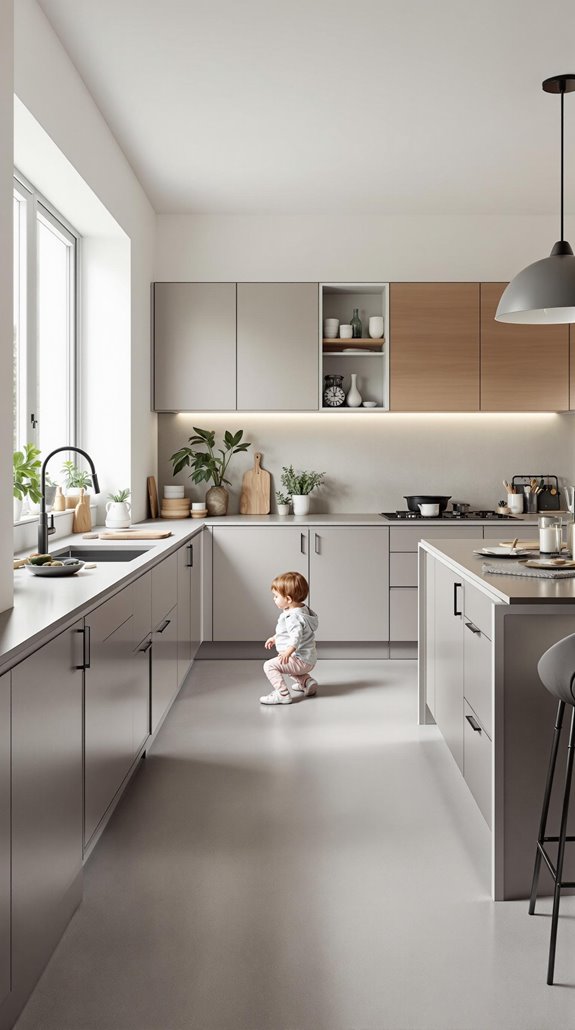
While aesthetics and durability matter, I’m betting your family’s safety ranks higher on your priorities. Micro cement delivers multiple protective features that’ll give you peace of mind throughout your home.
The anti-slip treatment creates secure footing in wet areas like bathrooms and kitchens, drastically reducing fall risks for children and elderly family members. You’ll appreciate knowing your floors maintain traction even when exposed to water or spills. Early detection of damp issues is crucial to ensure that slippery surfaces do not become a hazard.
Fire resistance provides essential protection in high-risk zones, particularly kitchens and facades. This non-combustible material meets building safety standards while maintaining structural integrity under extreme temperatures.
The waterproof barrier prevents moisture damage and mold growth, creating healthier indoor environments. Plus, the non-porous, chloride-free surface resists bacterial accumulation while avoiding toxic emissions that could irritate sensitive skin. The eco-friendly composition crafted from recycled materials further ensures no harmful substances compromise your family’s health.
Why Choose Micro Cement Over Traditional Materials
Although traditional renovation materials have served homeowners for decades, micro cement consistently outperforms them across every metric that matters for your project. While conventional tiles crack under UK temperature fluctuations and require constant grout maintenance, I’ve found micro cement’s flexible composition absorbs impacts without damage. You’ll eliminate the tedious resealing schedules that stone and concrete demand, since micro cement resists stains and moisture naturally.
Traditional materials force you into costly demolition, but micro cement adheres directly over existing surfaces. This means you’ll complete your renovation faster with minimal disruption. The seamless finish outperforms segmented tiles by preventing dirt accumulation and creating that modern aesthetic we’re all seeking. Most importantly, micro cement’s extended lifespan means you won’t face replacement costs that traditional materials inevitably demand.
The versatility of micro cement extends to its aesthetic potential, offering customizable colors and various finish options from matte to polished to complement any interior design scheme.
Cost-Effective Solutions for Modern UK Properties
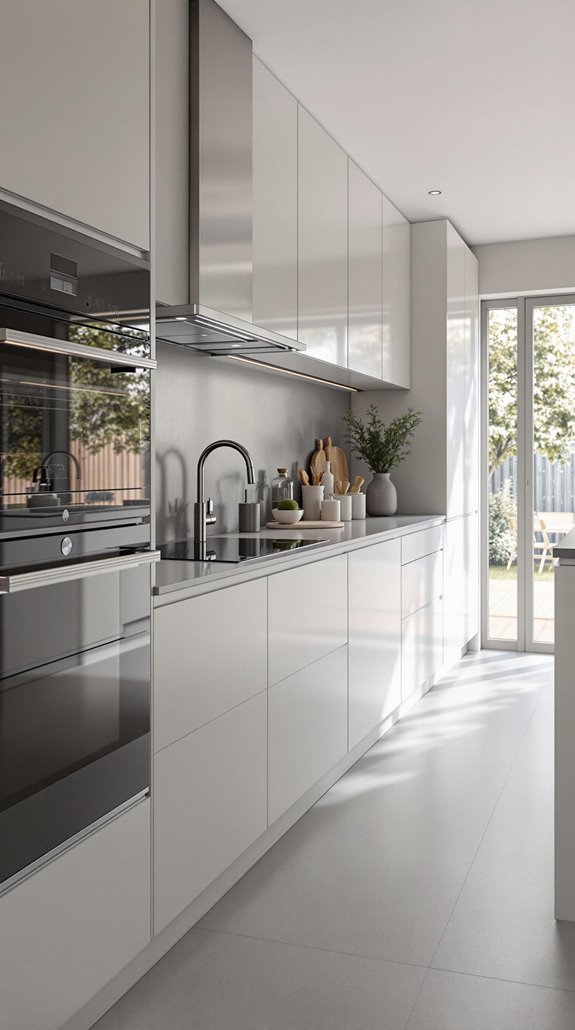
Three factors determine micro cement’s cost-effectiveness for your UK renovation: material pricing, project complexity, and long-term savings compared to traditional alternatives.
I’ve found standard rates range £100–£180 per m², with floors typically costing £120–£160. You’ll face minimum fees of £3200 + VAT for walls and £4200 + VAT for floors, making smaller projects less economical due to fixed costs. Regional price variations can also affect overall expenses, so it’s worthwhile to consult local pricing guides.
Complex elements increase pricing markedly. Bathroom applications add 30% premiums, while curved surfaces raise costs 20–40%. However, you’ll avoid demolition expenses by overlaying existing tiles, and the 2–3mm thickness reduces material volumes substantially.
The real value emerges long-term through reduced maintenance versus grouted surfaces, faster installation speeds, and seamless durability that outperforms traditional materials across typical UK property conditions. The multiple layers application process requires extended curing times, which impacts project scheduling but ensures superior adhesion and finish quality.
Conclusion
I’d recommend micro cement for your next UK renovation project. You’ll get exceptional durability, water resistance, and versatility that traditional materials can’t match. The installation process is straightforward, and you’ll save money on demolition costs since it applies over existing surfaces. With minimal maintenance requirements and excellent safety features, it’s a practical choice that’ll keep your home looking modern for years. Consider it for kitchens, bathrooms, and high-traffic areas where performance matters most.
References
- https://www.microcementec.com/en/microcement-and-its-properties-an-versatile-material/
- https://www.chromatist.com/2025/01/06/top-microcement-finish-ideas-and-trends-for-2025/
- https://www.imperaitalia.com/blogs/news/what-microcement-trends-can-expect-in-2025
- https://www.directstone.co.uk/microcement-vs-polished-concrete/
- https://livingconcrete.co.uk/product/microcement-coating/
- https://ldfmicrocement.co.uk/advantages-of-microcement-in-the-uk/
- https://www.ktcoatings.co.uk/documents/10-Benefits-of-Using-Microcement-in-Home-Renovations—KT-Coatings.pdf
- https://www.topciment.com/en/new/opinions-on-microcement-pros-and-cons-of-this-coating
- https://www.dsb8.co.uk/post/complete-guide-to-microcement-benefits-uses-and-application-techniques
- https://clairedouglasstyling.co.uk/post/what-is-microcement

